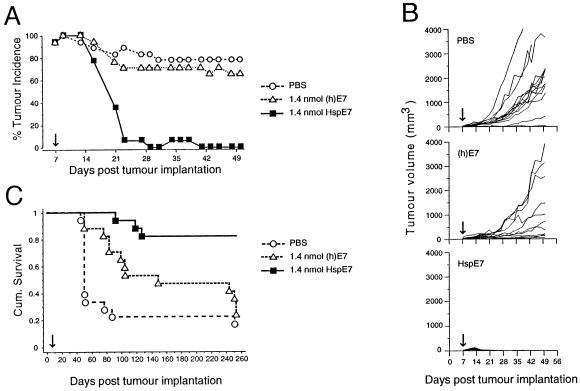Fig 1.
A single therapeutic immunization with HspE7 induces TC-1 tumor regression and promotes long-term survival. C57BL/6 mice were injected SC in the hind flank with 1.3 × 105 TC-1 cells (day 0). Seven days postimplantation, when measurable tumor (2 × 2-mm minimum) was apparent in all animals, mice were arbitrarily assigned into groups (17 to 18 animals per group) and immunized SC in the scruff of the neck with either PBS, 1.4 nmol of (h)E7, or 1.4 nmol HspE7 (arrow). The same cohorts of PBS (O), (h)E7 (▵), or HspE7 (▪)-treated mice were used to produce the data displayed in (A), (B), and (C). (A) Percentage tumor incidence in mice receiving HspE7 therapy. Mice were scored for the presence or absence of a palpable SC tumor nodule for 50 days postimplantation. (B) Individual tumor volumes from mice receiving HspE7 therapy. Tumor volumes of SC nodules were assessed for 50 days postimplantation. (C) Long-term survival in mice receiving HspE7 therapy. Mice were monitored for survival over a 253-day period postimplantation. Mice that became moribund because of tumor burden were sacrificed. Time to death is plotted on a Kaplan-Meier survival curve (reprinted with permission; see author's note).

